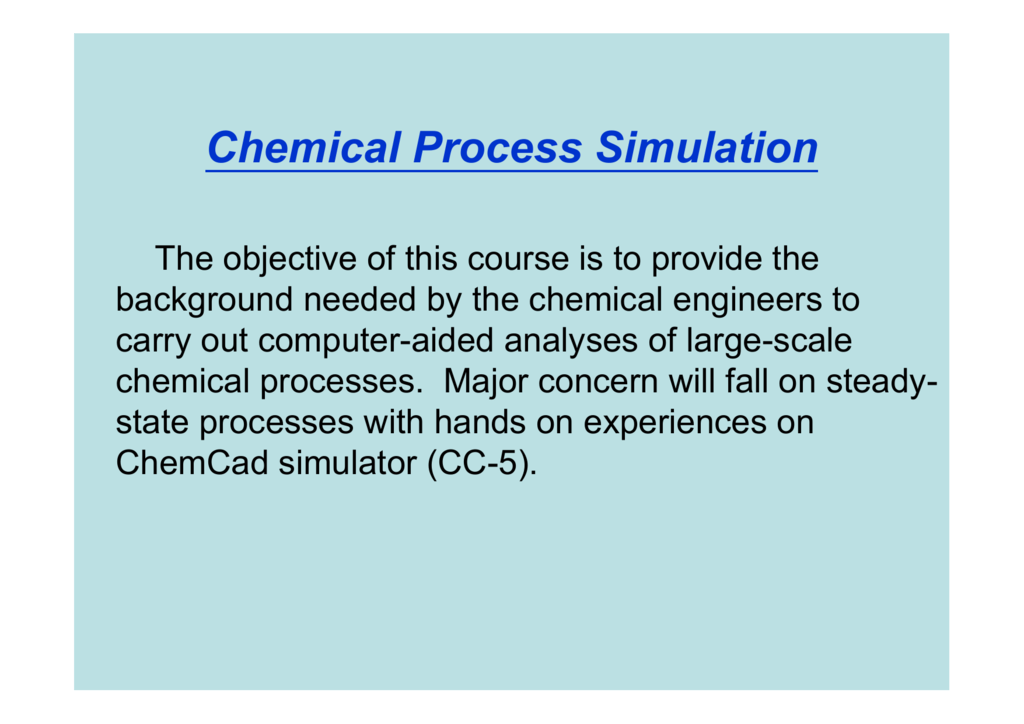

Problems Chapter 8 Dynamic Process Analysis 8.1. Optimization in Sequential Simulators 7.4. Classification of optimization problems 7.3. Introduction 7.2 Formulation of optimization problem 7.2.1. Problems Chapter 6 Gas-Liquid Separation Operations 6.1 Introduction 6.2 Available modules in Aspen Plus(R) 6.2.1 Shortcut Methods 6.2.2 Rigorous Methods 6.3 Modules available in Aspen Hysys(R) 6.3.1 Predefined Columns 6.3.2 Shortcut Calculation Model 6.3.3 Column Interface 6.4 Distillation Introductory Example 6.4.1 Problem Description 6.4.2 Simulation In Aspen Plus(R) 6.4.3 Simulation in Aspen Hysys(R) 6.4.4 Results Analysis and Comparison 6.5 Absorption Introductory Example 6.5.1 Problem Description 6.5.2 Process Simulation 6.6 Enhanced Distillation 6.6.1 Residue Curves Map (RCM) 6.6.2 Extractive Distillation 6.7 Non-Equilibrium Models 6.7.1 Non-Equilibrium Model Example 6.8 Columns Thermal And Hydraulic Analysis 6.8.1 Application Exercise 6.9 Summary 6.10 Problems Chapter 7 Process Optimization in Chemical Engineering 7.1. Process Simulation in Aspen Plus(R) 5.7.3. Problems Chapter 3 Fluid Handling Equipment 3.1 Introduction 3.2 General Aspects 3.2.1 Background 3.2.2 Piping 3.2.3 Pumps 3.2.4 Compressors and Expanders 3.3 Modules available in Aspen Plus(R) 3.4 Modules available in Aspen HYSYS(R) 3.5 Gas Handling Introductory Example 3.5.1 Problem Description 3.5.2 Simulation in Aspen HYSYS(R) 3.5.3 Results Analysis 3.6 Liquid Handling Introductory Example 3.6.1 Problem Description 3.6.2 Process Simulation 3.6.3 Results Analysis 3.7 Summary 3.8 Problems Chapter 4 Heat Exchange Equipment and Heat Integration 4.1 Introduction 4.2 Types of Programs Available 4.3 General Aspects 4.3.1 Shortcut Calculation (Holman, 1999) 4.3.2 Rigorous Calculation (Holman, 1999) 4.3.3 Calculation models 4.4 Modules available in Aspen Plus(R) 4.5 Modules available in Aspen HYSYS(R) 4.5.1 Thermodynamic Heat Exchangers 4.6 Introductory Example 4.6.1 Problem Description 4.6.2 Simulation in Aspen Plus(R) 4.6.3 Simulation in Aspen HYSYS(R) 4.6.4 Simulation in Aspen HTFS(R) 4.6.5 Results Analysis 4.7 Process Heat Integration 4.7.1 Introduction 4.7.2 Theoretical principles 4.7.3 Aspen Energy Analyzer 4.8 Summary 4.9 Problems Chapter 5 Chemical reactors 5.1 Introduction 5.2 General Aspects 5.3. Integration of the activity models with equations of the state 2.7. Problems Chapter 2 Thermodynamic and property models 2.1. Sensitivity Analysis in Aspen HYSYS(R) 1.8. Sensitivity Analysis in Aspen Plus(R) 1.7.2. Partitioning and topological analysis 1.5.4. Applications of process simulation 1.4.1.

Simultaneous or Equation oriented simulators 1.3.2. Preface Chapter 1 Process Simulation in Chemical Engineering 1.1.


 0 kommentar(er)
0 kommentar(er)
